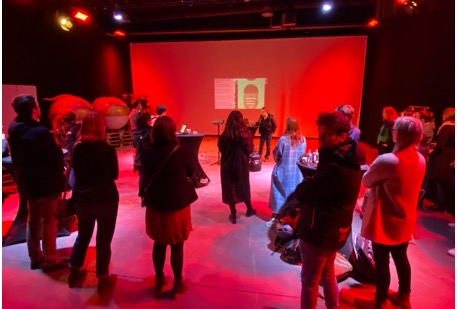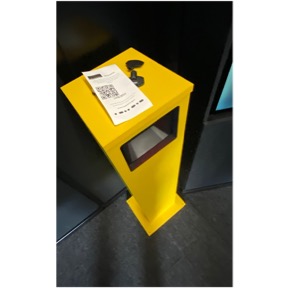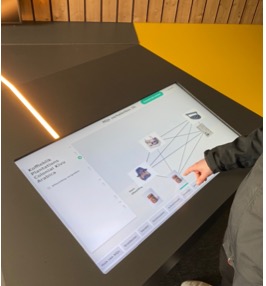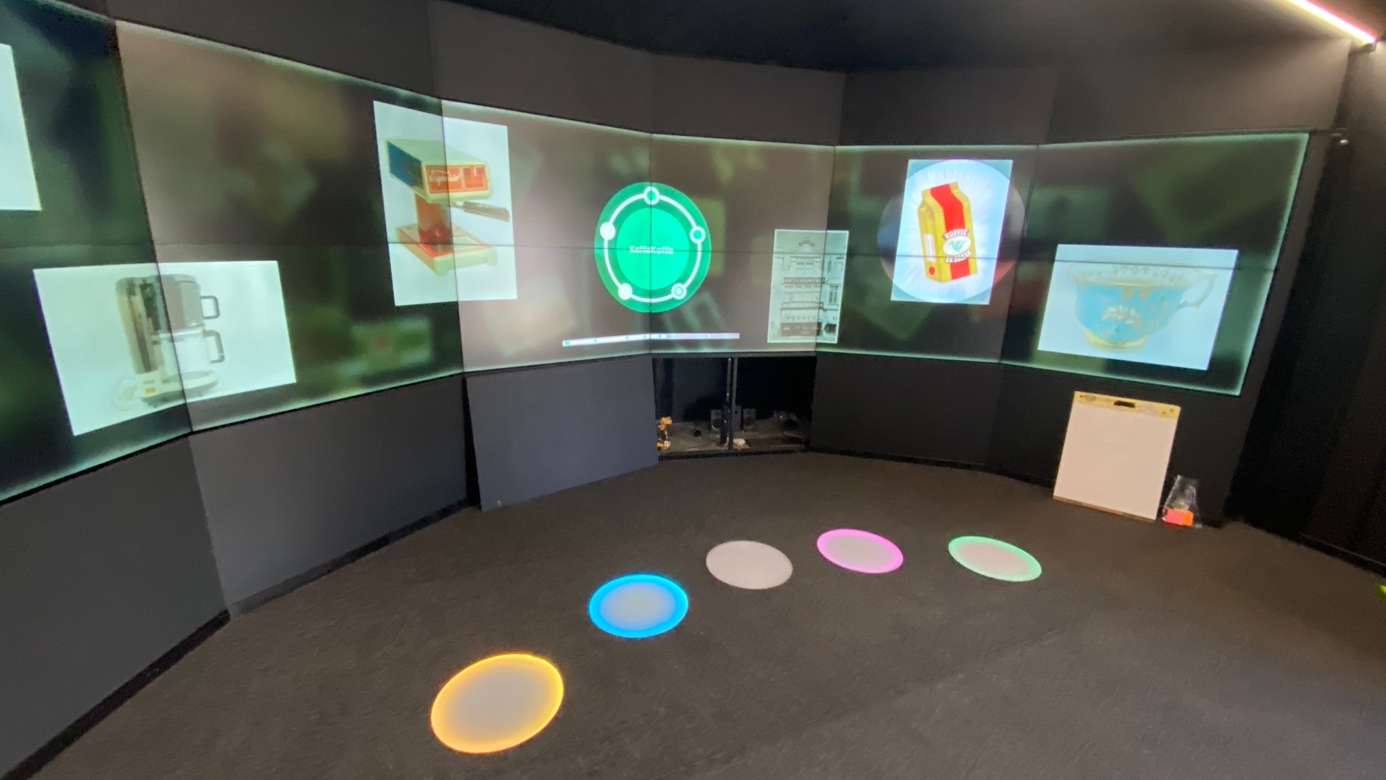
COGHENT BOX: WHAT'S IT LIKE?
"So, what do you think of the Box?” Today, the partners of the CoGhent project are gathering around the prototype of the mobile module called CoGhent Box, which will make it possible to test the provision of digital collections and their enrichment in 3 neighbourhood of the city. The day's programme looks like a state of the art of the project and takes place on the site of the Fisheye company in Wetteren, on the outskirts of Ghent, which is responsible for manufacturing the Box prototype.
The question "What do you think of the Box?” has not been asked only to me. It was on the minds of all the participants. I therefore propose to return it to all the stakeholders of the project and to make it the heart of this article...
FINALLY, SOMETHING TANGIBLE!
"I am happy to see that all this is finally taking shape", confided one of the community worker in charge of the neighbourhood involvement in the project[i]. It is not so much the prototype that stakeholders are talking about as the fact that there is something tangible that crystallises the long process of interaction between heterogeneous actors in a complex project like CoGhent, especially after all the obstacles that the health crisis has posed in terms of citizen participation.

GoGhent team at large gathering for a state-of-the-art day at Fisheyes prototyping workshop (photo credit: F. Jégou)
In-situ
The choice of the organisers to hold a meeting of the project partners in the Fisheye workshops is not a coincidence. Of course, the prototype of the CoGhent Box is being built there and it is natural to organize there the day of 17 March devoted to a meeting of the project's business steering group, a progress report on CoGent project with the entire consortium, an overview of the CoGent Box, user tests and a workshop on narrative processes. But it is also a deliberate choice to gather all the project partners on the field, in a part of the production workshops for a succession of slide presentations, standing up on a still fresh morning in mid-March: after 2 years of social distancing and online workshops, the project actors needed something concrete!
Creating reality
"Attention, here it is forbidden to take pictures. All the objects you see around you are confidential..." says one of the Fisheye managers. Around, indeed, some elephants scale 1 in coloured plexiglass facet, a pair of giant eyes, half-columns of Corinthian inspiration in polystyrene covered with resin...Difficult to describe where we are? On the Fisheye website it says: "Fisheye is a multidisciplinary production company that combines creative thinking with craft and technology to create unforgettable experiences”. In concrete terms, Fisheye's building is that of a large SME. It is located in a business park in Wetteren, south-east of Ghent. You arrive in a large, more or less organised car park. Entrance door ajar. Glazed office space and a series of screens for 3D design. And above all, huge prototyping workshops equipped with a giant 5-axis digital milling machine, laser metal cutting, water jet cutting table, paint shop and storage racks as far as the eye can see...
How does it help us to understanding the CoGhent project? What is striking about Fisheye is the dimension of "machine for creating reality on a large scale", especially on the fantastic side and on non-standard dimensions. The company is particularly active on festival stages, theme park sets, interactive installations, immersive exhibitions, theatre sets... This ability to make something tangible that does not yet exist is key to the implementation of innovation projects: prototyping on a scale of 1 something that does not yet exist and make it a reality!
TRANSCENDING THE CO-CREATION PROCESS?
So, what about the CoGhent Box that everyone is wondering about today? Beyond making the project tangible, does the prototype presented succeed in inventing a new reality that matches the project's ambitions?
These questions lead to a classical controversy between participatory design and authorial design that can be summarised as follows: should the result of the design process of an innovation be the strict synthesis of the co-construction by the stakeholders or should it transcend the compromise to bring something that appears to be an unprecedented but nevertheless expected creation? Design would reveal a latent reality. It would reinterpret 'weak signals', emerging trends to create what all users felt they were expecting and then found obvious.
New meanings?
So then, what about the CoGhent Box? The CoGhent innovation project aims to achieve a series of unprecedented objectives: to digitise the contents of the city's museum collections, to mix them in narrative processes to bring the collective memory to life, to interact with all the inhabitants to increase cultural cohesion, etc. So many innovative dimensions that call for materialization in a design that should embodies these new meanings...
How would you describe the CoGhent Box (which can be seen in the photos in the article) and above all how the project partners interpret it? The result is definitely a hybrid. The clean, white exterior is somewhere between an art biennial pavilion and a "project house" such as is installed in neighbourhoods undergoing rehabilitation. The interior, on the other hand, plunges the visitor into the dark for a better visualization of the screens and oscillates between the control console of a science-fiction film and the interactive immersive universe typical of science and technology museums. “It is a bit like a piece of a museum to settle in the neighbourhood” said one participant, a piece that would have been detached from a chic cultural institution of the city centre to act as an ambassador for it in the various districts of the city.
One may wonder whether something new has been invented or whether we are in the presence of a somewhat eclectic result matching the CoGhent’s co-construction between the world of cultural institutions and the tech world of data architecture and user interface.
This form of eclecticism can be disappointing because it does not create new strong and transcendent meanings. Nevertheless, it is an object in tension, a form of questioning that needs to be resolved as the experiments in the city's districts begin in mid-April.

CoGhent partners discovering the prototype of the mobile CoGhent Box that will be experimented in 3 successive neighbourhoods of the city (photo credit: F. Jégou)
An open design?
"We wonder if the CoGhent Box will be degraded following its successive installation in the three neighbourhoods, especially one that is more difficult" confides one of the actors present around the prototype. It is a good question, asked in a judiciously ambivalent way: is it feared that the prototype will be vandalised, which would hinder its reinstallation, at the end of the project, in the new wing of the City Design Museum? Or is it hoped that the CoGhent Box will be transformed by its experimentation in the field, which would be a sign of its interaction and appropriation?
"This 'white box' aspect will disappear with the graphics that will be applied to the different façades," reassures one of the project partners. The rear face in raw wood contrasts with the front white facade. “It will be covered with tags, explains one of the actors around the Box, and part of these panels will be replaced at each new installation so that each neighbourhood will keep a trace of the Box's passage”.
The success of this attempt to limit taggers' interventions on the back side in the vein of policies to control graffiti on dedicated walls is questionable. “I hope that the Box will come back from its journey in the neighbourhoods like an old piece of luggage, concludes another actor around the Box, covered with tags and marks that will bear witness to its adventure in the field!”


Ticket scanning device to access the collection browsing and navigation system (photo credit: F. Jégou)
A pragmatic user interface design?
What happens inside the Box? There are essentially two areas: to the right of the entrance is a station for consulting the collections using a touch screen and display screens. It offers essentially an intuitive and thematic navigation in the collections. On the left, 5 screens in an arc propose a process of exploration of the digitised cultural content on the basis of narratives: Generic stories combining content drawn from the city's partner cultural institutions (e.g. The caféas a transversal theme of exploration of the city's collections) and Specific stories which emerge from interactions with the inhabitants in the neighbourhoods (e.g. Memories of Neptune, a swimming pool and leisure centre which remains anchored in the memory of the inhabitants of the Wondelgem neighbourhood). For the time being, 2 prototypes of each category are available for the demo.
This second navigation zone, based on stories, is more original and experimental and begins to answer, through its pragmatic dimension of the interface, the question of use that underlies the concept of the CoGhent project: what will the opening of digitised cultural data allow? As with any operation to open up public data, what new uses will it generate and how does it all look?
- « When entering, visitors take a ticket on the yellow terminal » The QR code allows visitors to explore the stories available on the CoGhent Box screens, but also to return home to their own navigation item and continue to explore new stories. The experience of consulting the media in situ appears to be more of a gateway to the process, a pretext for distributing an entry ticket to the digital collections that can be consulted at home and for which the absence of the CoGhent Box's multi-screen capability does not seem to be a determining factor.

Multi-screens interactive display where visitors can navigate stories combining museum collections and populations’ memories (photo credit: F. Jégou)
- The system of interaction with the screens is done by moving on luminous points on the floor, the visitor's body interacting with sensors placed in the ceiling of the Box. Here again, the choice of a solution well known from interactive museographic devices, more pragmatic than original, produces an interesting choreography of visitors among themselves. It is accessible to all ages and easily includes people with disabilities.
- “To make these first demos, we recorded the stories ourselves without using professional speakers. And we ask ourselves what is best...", says one of the organisers. Here again the pragmatism of rapid prototyping takes precedence over the research of perfection which often hinders experimentation in public action: the quality of the instantaneous, the voice recorded on the fly, imperfect but so much truer than the impersonal and flat result of an over-licked design.
- The afternoon workshop with authors, writers and professional storytellers explore the process of creating stories and composing narratives in interaction with formal museum collections and informal collections collected from the inhabitants. The design of the project puts less emphasis on the result (a modest slide show of archival images scrolling over a narrative) to allow room for co-construction (empowering the authors in the process of story creation).
TIME FOR CO-CONSTRUCTION
Taking part to a just launched UIA capitalisation exercise entitled: "Urban innovation and covid-19 - Coping with and learning from on-field practice through UIA projects", I cannot help but look at this day from this perspective, which everyone is hailing as a long-awaited materialisation of the project after 2 years of work in a context of pandemic, social distancing and online meeting tunnels. In particular, what does it say about how the CoGhent project got through this difficult period when the project was heavily dependent on the ability to work together and co-construct with citizens? In particular how does the city respond to operational challenge n°4 "Participatory approach for co-implementation", when the observations on what covid has changed in public action[ii] underline the stand-by of participatory actions and the breakdown of citizen consultation processes?
Taking the time
The long period of confinement and more or less pronounced distancing since March 2020 does not seem to have disrupted CoGhent's initial schedule too much! Certainly, the difficulties of the engagement work in the field, the fatigue of the remote collaboration for the project team were obvious brakes. But this long period of mutual acculturation was necessary. It takes time to bring together heterogeneous actors, to get a wide range of different skills to collaborate, from data architectures to social cohesion through culture, and to bring out a real process of co-implementation in a complex project like CoGhent.
Culture of participation
The culture of participation which characterises a city like Ghent goes beyond the impossibility of carrying out participatory actions. Above all, it is embodied in the ability to leave room for co-construction by publicly presenting unresolved, open objects. The project is sufficiently framed to ensure that it runs smoothly in the time allowed, but with sufficient room for the contributions of all the stakeholders, for mutual influences in a co-construction process.
The design controversy between "too much co-construction versus too much pre-design" posed in the opening remains. The CoGhent project must find its balance between a rich collaborative process and a result that makes a difference!
[i] The quotes were captured during informal conversations and therefore preserve the anonymity of their authors
[ii] For example, the study "Réflexes Publics - Investigation on public resilience in times of crisis" (https://www.la27eregion.fr/en/reflexes-publics-investigation-on-public-resilience-in-times-of-crisis/) published by the 27th Region in France which inspired the capitalisation process launched by UIA: "Urban innovation and covid-19 - Coping with and learning from on-field practice through UIA projects”
About this resource
The Urban Innovative Actions (UIA) is a European Union initiative that provided funding to urban areas across Europe to test new and unproven solutions to urban challenges. The initiative had a total ERDF budget of €372 million for 2014-2020.
Similar content




